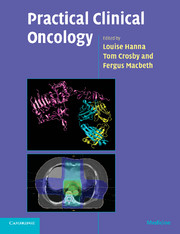Book contents
- Frontmatter
- Contents
- List of contributors
- Preface
- Acknowledgements
- Abbreviations
- 1 Practical issues in cytotoxic chemotherapy usage
- 2 Biological treatments in cancer
- 3 Hormones in cancer
- 4 Radiotherapy planning
- 5 Research in cancer
- 6 Oncological emergencies
- 7 Palliative care
- 8 Head and neck
- 9 Oesophagus
- 10 Stomach
- 11 Liver, gallbladder and biliary tract
- 12 Exocrine pancreas
- 13 Colon and rectum
- 14 Anus
- 15 Gastrointestinal stromal tumours
- 16 Breast
- 17 Kidney
- 18 Bladder
- 19 Prostate
- 20 Testis
- 21 Penis
- 22 Ovary
- 23 Body of the uterus
- 24 Cervix
- 25 Vagina
- 26 Vulva
- 27 Gestational trophoblast tumours
- 28 Lung
- 29 Mesothelioma
- 30 Soft tissue and bone tumours in adults
- 31 The lymphomas and myeloma
- 32 Central nervous system
- 33 Skin cancer other than melanoma
- 34 Melanoma
- 35 Thyroid
- 36 Neuroendocrine tumours
- 37 Cancer in children
- 38 Cancer of unknown primary
- 39 The use of radiotherapy in the treatment of benign conditions
- Multiple choice questions
- Multiple choice answers
- Index
- References
31 - The lymphomas and myeloma
Published online by Cambridge University Press: 23 December 2009
- Frontmatter
- Contents
- List of contributors
- Preface
- Acknowledgements
- Abbreviations
- 1 Practical issues in cytotoxic chemotherapy usage
- 2 Biological treatments in cancer
- 3 Hormones in cancer
- 4 Radiotherapy planning
- 5 Research in cancer
- 6 Oncological emergencies
- 7 Palliative care
- 8 Head and neck
- 9 Oesophagus
- 10 Stomach
- 11 Liver, gallbladder and biliary tract
- 12 Exocrine pancreas
- 13 Colon and rectum
- 14 Anus
- 15 Gastrointestinal stromal tumours
- 16 Breast
- 17 Kidney
- 18 Bladder
- 19 Prostate
- 20 Testis
- 21 Penis
- 22 Ovary
- 23 Body of the uterus
- 24 Cervix
- 25 Vagina
- 26 Vulva
- 27 Gestational trophoblast tumours
- 28 Lung
- 29 Mesothelioma
- 30 Soft tissue and bone tumours in adults
- 31 The lymphomas and myeloma
- 32 Central nervous system
- 33 Skin cancer other than melanoma
- 34 Melanoma
- 35 Thyroid
- 36 Neuroendocrine tumours
- 37 Cancer in children
- 38 Cancer of unknown primary
- 39 The use of radiotherapy in the treatment of benign conditions
- Multiple choice questions
- Multiple choice answers
- Index
- References
Summary
Introduction
The haematological malignancies make up a group of diverse diseases ranging from the very indolent, which may co-exist with the patient for many years, to the highly aggressive and rapidly fatal. They can occur anywhere in the body, and so this chapter is based on tumour type rather than anatomical site, although a detailed anatomical knowledge is required for treatment planning.
Apart from making a tissue diagnosis, surgery rarely has a part in the management of these patients, thus, the development of curative treatment protocols for many of these patients has been a success story for chemotherapy and radiotherapy (RT). With more patients surviving longer, attention is focussing on minimising the unwanted late effects of treatment as much as on maximising the chances of a cure. Patients should be managed by multidisciplinary teams that bring together the appropriate expertise of haematologists, oncologists, radiologists, pathologists and specialist nurses.
This chapter first considers the lymphomas, namely non-Hodgkin lymphoma and Hodgkin lymphoma. Then it considers the paraproteinaemias, which include multiple myeloma and solitary plasmacytoma. Lastly, it considers total-body irradiation, which is given as preconditioning prior to bone marrow transplantation in some lymphomas and leukaemias. Leukaemia in children is considered in Chapter 37 (see p. 431). However, a detailed discussion of adult leukaemias is outside the remit of this book.
Lymphomas: general aspects
Introduction
Non-Hodgkin lymphoma (NHL) is the seventh most common cancer in the UK, with a yearly incidence of about 9000 new cases, and occurs mostly in patients over age 65.
- Type
- Chapter
- Information
- Practical Clinical Oncology , pp. 347 - 369Publisher: Cambridge University PressPrint publication year: 2008



